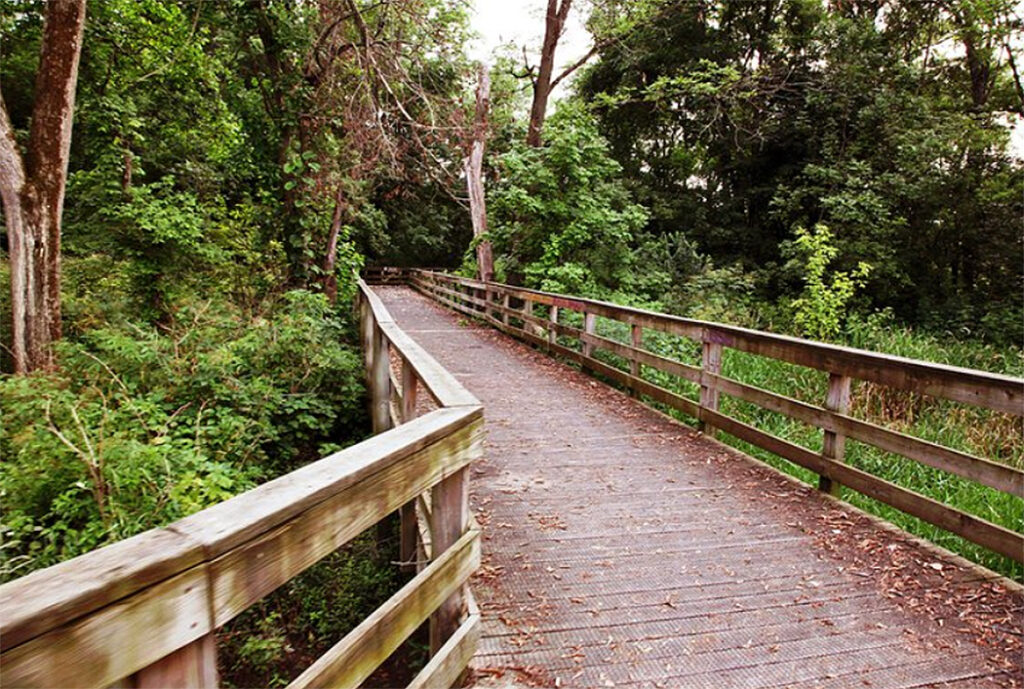
Iowa’s 90 state preserves were designated as such to bear witness to the outstanding biological and botanical features they possess. Many contain excellent remnants of the prairies and forests that once dominated this state. Others hold plants and animals now rare in Iowa.
Recently, I tagged along with District Forester Cassidy Widner, DNR Biologist and Preserves Coordinator John Pearson, and local botanist Laura McCormick as they inspected Lamson Woods State Preserve in Fairfield. We were looking for results from a recent management plan at the preserve.
Origins of the Management Plan
Like many forests that are neglected, Lamson Woods lacked the ability to regenerate indigenous trees such as oaks, hickories, and black walnuts. Since Lamson Woods is a state preserve, the Iowa DNR proposed that Ray Lehn, our local district forester at the time, write up a management plan. This document was reviewed by the Fairfield Arbor Committee and presented to the Fairfield City Council, which unanimously approved it.
Step One: Thinning
The first step of the DNR-approved management plan was to thin 106 oak trees across 18 acres, which came out to an average of six trees per acre. This step was done to help stimulate the regeneration of oaks and hickories, which are not shade tolerant and need abundant sunlight. The older canopy trees chosen for removal were on the decline from disease, stress, or age and would not be living much longer.
The management plan was implemented to restore ecosystem function, not to harvest timber for profit. Nor was the primary objective to rid the woods of invasive plants alone—it was to encourage the growth of keystone species that are best adapted to our changing climate.
Oaks, hickories, and black walnut are keystone species that are the foundation of the food chain. Many animals feed on the acorns or nuts, and caterpillars (used by birds to feed their young) will feed on the leaves. The absence of the regeneration of oaks, hickories, and black walnuts indicates an ecosystem in decline, with diminished support for wildlife. Such was the case at Lamson Woods.
Step Two: Removing Invasives
After thinning trees, the next step was initial spot-treatment of invasive shrubs, such as honeysuckle and barberry. The least possible amount of herbicide was used and was applied directly on the small stumps of the shrubs to ensure that the plant’s roots died. The invasive species are removed because these Asian species did not evolve with our native insects and thus they are not used by our native insects for food.
Many birds and bats eat insects more than any other source of food. If the insects starve due to lack of native vegetation, then bird and bat populations also decline. There are many forest and meadow bird populations in Iowa that are now dwindling due to lack of ecosystem management (whip-poor-wills are a good example).
Step Three: Controlled Burn
The last step of the management plan was to remove the forest underbrush, such as Ohio buckeye, elm, and hackberry saplings to increase sunlight to the forest floor and stimulate regeneration. There was a prescribed low-intensity fire to the forest floor to remove the thick duff layer that also blocked sunlight. The burn also helped to make nutrients more readily available and thus stimulate plant growth.
A Deluge of Regrowth
The results from all these practices were overwhelmingly positive: the team found hundreds of baby oak seedlings and rare woodland plants. The management plan is working as projected, based upon scientific understanding and practices. District Forester Widner was especially pleased about the natural regeneration of oaks that is occurring: it’s likely that no outside seedlings will need to be planted, keeping the genetics of the original forest intact.
Admittedly, the first two years after implementation, parts of Lamson Woods looked ragged and disjointed, but the sunlight now streaming to the forest floor has triggered a tsunami of rebirth: in addition to young tree seedlings, woodland plants and flowers not seen in decades are reappearing and thriving.
Hidden within this rebirth is a lesson for us all, a concept attributed Aldo Leopold, that in land stewardship, humans don’t come first. Our concepts of beauty and correctness are sorely lacking in understanding the big picture.
The land comes first, even if that’s initially difficult to see beyond the temporary surface conditions. Tried and true conservation methods that take into account the full spectrum of ecological health are helping heal and regenerate some of Iowa’s land, prairies, and forests.
Ron Blair acknowledges the contribution of conservation experts in writing this article.
